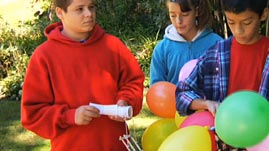Teachers' Domain - Digital Media for the Classroom and Professional Development
User: Preview


Source: Mission: Solar System/DESIGN SQUAD NATION
Cars use airbags. Packages use airbags. Why shouldn’t eggs use airbags, too? In this video from Design Squad Nation, kids use balloons and other readily available materials to design and build a shell that can protect an egg when it is dropped from a height of three feet. Their systems model the airbag landing systems used by three NASA Mars missions. As they build their shell, the kids use the engineering design process, apply a variety of science concepts (e.g., force and energy), and learn about NASA’s exploration of the solar system.
Soft Landing Challenge—Leader's Notes and Kid's Handout (Document)
Erick Ordoñez: Materials Engineer (Video)
Mission: Solar System Teacher's Guide (Document)
Mission: Solar System Training Video (Video)
Teacher's Guide
Check out the Mission: Solar System—Teacher's Guide (PDF)! It gives you an overview of the project’s four components and how to use them to run a challenge—start to finish. In addition, there are resource pages that offer tips for implementing Mission: Solar System’s challenges. For example, there are ideas for how to help kids use the design process and suggestions for effective ways to talk to kids about engineering. You’ll also find related online resources from NASA and Design Squad, education standards, and professional-development resources.
Videos
 Loading Standards
Loading Standards